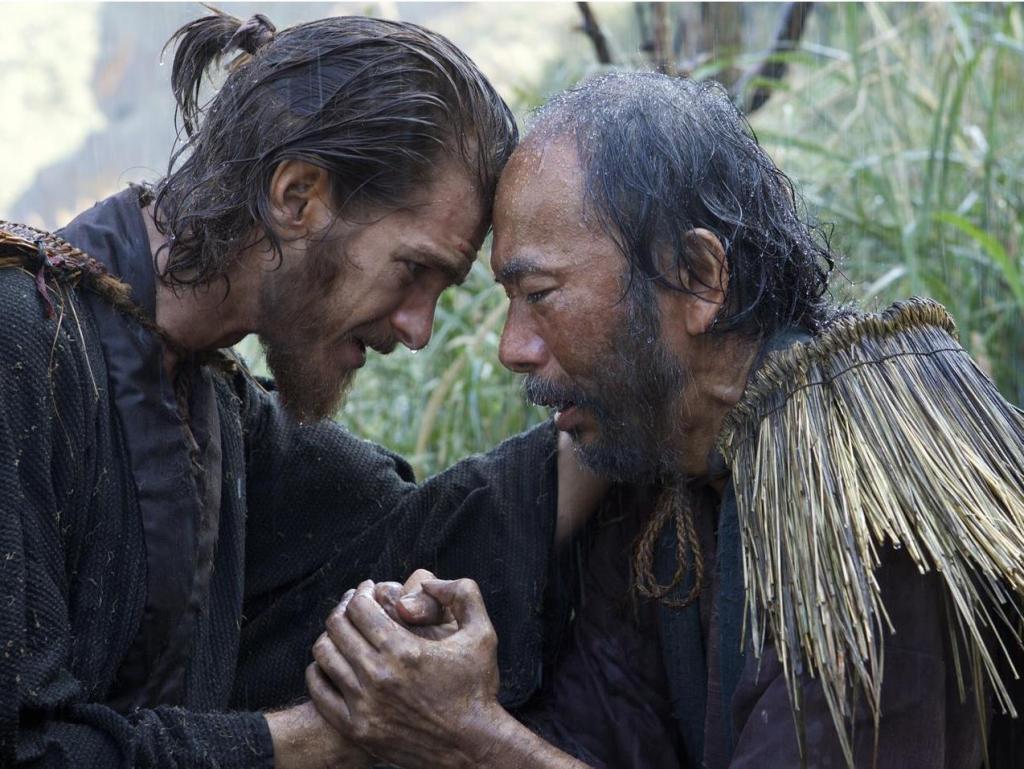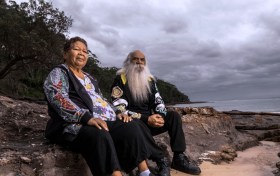Andrew Garfield (left) in Silence. Image via Transmission Films.
Couched not in quiet, but in the purposeful sound of chirping of crickets, Silence begins with two acts of faith that will shape the course of the feature to come. One Portuguese priest endures physical torment in a country inhospitable to his religion, while a pair of his protégés is adamant that reports of his subsequent apostasy cannot be accurate. In narration overlaid upon misty scenes of torture, crucifixion and execution, Father Cristóvão Ferreira (Liam Neeson, Operation Chromite) speaks of the strength required to maintain belief in trying circumstances. In a softly voiced discussion with their superior Father Valignano (Ciarán Hinds, Bleed for This) in Italy, Fathers Francisco Garupe (Adam Driver, Paterson) and Sebastião Rodrigues (Andrew Garfield, Hacksaw Ridge) remain resolute that their mentor has not and would not abandon all that they stand for.
Discovering the simple truth of the situation may provide the film’s narrative with its drive, but if there’s one thing that writer/director Martin Scorsese (The Wolf of Wall Street) makes plain in his Jay Cocks (De-Lovely)-co-scripted adaptation of Shûsaku Endô’s novel of the same name, it’s the many complications that inspire, guide and sustain dedication to a spiritually minded existence. Having faith can be considered a state of stillness, hence the feature’s title, Ferreira’s lack of protest in the movie’s opening moments, and Garupe and Rodrigues’ stoic determination; however, as the rampant suffering and opposition all three padres will face demonstrates, complexities persist like the inescapable noise of insects.
The bulk of Silence addresses the inherent contrast that plagues those who believe: adherence appears easy, yet always proves otherwise, even more so given the lack of vocal encouragement or solace from their chosen deity. Dispatched on a Ferreira-finding mission, Garupe and Rodrigues arrive in secret in 17th century Japan, their fervour and certainty seeping from their pores even in a place where Christianity is outlawed. Accompanied on their journey by troubled fisherman Kichijiro (Yôsuke Kubozuka, Tokyo Tribe), and soon taken in by a sympathetic village, what they find exceeds even their bleakest expectations. ‘The black soil of Japan is filled with the wailing of so many Christians,’ Rodrigues’ letters comment, but with inquisitor Inoue (Issei Ogata, Teacher and Stray Cat) on their trail, more can only follow. Tests of faith build into an onslaught, whether the central duo is bearing witness to the horrific trials and tribulations forced upon others, sneaking their way across the country on their search for their beloved teacher, or experiencing the bleak reality first-hand.
Turning their ordeal into 161 patient minutes of perils and pondering, Silence might be seen to test Scorsese fans’ faith too – though, while the dichotomy between devotion and its rewards sits at the heart of his 25th feature, no such conflict shades the film’s existence. With The Last Temptation of Christ and Kundun also on his resume, the writer/director’s fascination with the subject has never been far from view; indeed, even when religion hasn’t overtly reared its head in entries in his 50-year filmography, the topic has still simmered beneath the surface. Tales of belief have abounded in both his crime-oriented and romance-centric dramas, many charting acts of belonging, connection, engagement and adoration in varying forms. Two recent additions to Scorsese’s body of work, 2011’s family-friendly cinema love letter Hugo and 2014’s literature-focused The 50 Year Argument, perhaps couldn’t seem more different – to each other, and to what’s accepted as his typical violence-soaked mode of operation – yet still share his common fascination with worship.
Scorsese himself infuses love into every frame that evolves from his decades of contemplation and fascination, employing cinematographer Rodrigo Prieto’s images as a vessel for his affection. Revelling in symbolism, Japanese culture and the country’s natural surroundings, Silence is a film of aesthetic glory; befitting its thematic core, its scenic sights are coupled with visible murkiness, but the former always perseveres. The same can be said of the fortitude in the feature’s performances, with Neeson, Driver and Garfield perfecting both the serene and the struggling sides of their tumult-riddled characters. To stare into their eyes, as the movie often does, is to glimpse its complexities laid bare. When it comes to both lengthy looks and the questions of faith that inspire them, Silence has many.
Rating: 4 stars out of 5
Silence
Director: Martin Scorsese
USA | Taiwan | Mexico, 2016, 161 mins
Release date: February 16
Distributor: Transmission
Rated: MA
Actors:
Director:
Format:
Country:
Release:





